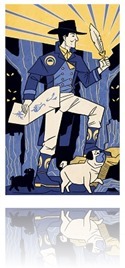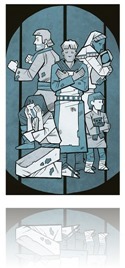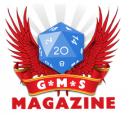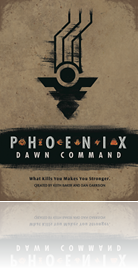Phoenix: Dawn Command is the result of Twogether Studios successful Kickstarter and a roleplaying game in which what kills you, actually make you stronger.
By Paco Garcia Jaen
The world of Dalea is very much in peril again. Generations after the Dread was brought to a halt by the Phoenix, darkness is coming back to the kingdoms and the flame of Pyre has lit again.
You are a Phoenix, a human reborn after learning secrets and training in The Crucible, a mystical place of learning and growth, with abilities beyond that of any mortal and with the sole purpose of protecting Dalea from the Dread. You have learned that death is not the end and that every time you die you come back to Dalea stronger, better than before.
But your death must be meaningful and you must choose carefully when to die, for you can only be reborn seven times before you can’t return.
Can you make it count?
Phoenix: Dawn Command has been authored by Keith Baker and Dan Garrison. Keith’s resume includes more games I can remember, but, just in case his name is not one you are familiar with, he created Eberron. Keith knew Dan Garrison and Dan had a great idea for a game: Death is what makes you stronger. And they started to work together.
The result was a Kickstarter that funded very successfully and broke a few stretch goals that saw people like Kenneth Hite, Robin D. Laws, Will Hindmarch, Nika Harper, Mary Robinette Kowal and others.
And at a price that I found pretty amazing. For 50$ you got the game with the stretch goals, and considering the game mechanics are card based, I thought it was pretty good value for money.
When I got my copy of the game I thought they had included a brick or something similar in the box. It was very heavy for my little muscles. Much to my delighted surprise, inside the box was a 460 pages small size book, more than 250 tarot size cards and a whole bunch of tokens.
The box is very sturdy, thicker than most boardgame boxes, and it has the right space for everything it comes with, though no insert and if you sleeve the cards, it might be a tad tight. with a size of 25 x 17 x 7 cms, it will probably get into any rucksack and fit in any shelf, keeping all your gamey bits tidy. You can tell I love games that come in boxes!
The book comes in a pretty decent quality paper and the binding is most excellent. It is a softcover, so nothing too fancy, but it has resisted my handling while I read it and it has come with me in several bags and rucksacks resisting easily enough and without any pages coming loose or anything like that. Even the top of the book barely has any crises.
So far so good.
The card material is pretty standard. It is coated, so it will resist touching by non-grubby fingers fairly easily. However, if you are going to play this game a lot, I would suggest sleeves.
There are different decks of cards. School (the type of Phoenix you are), Action cards (Grace, Strength or Intellect), Lesson (character abilities) and Challenge cards (basically, enemies) and each player starts with a hand of cards they can use to make a spread. Each appropriate card has a number and if the spread is equal or higher than the challenge, then the action succeeds.
There is also a card called The Torch. That card allows you to write a list of words, like the list of environmental items you find at a location. Why this is important I will explain later because it is a cool little feature of the game.
The artwork on the cards, which is repeated in the book too, is lovely. Line art illustration work with very simple style and limited palette. Think about the sort of glass windows you see in medieval churches (and maybe in not so medieval ones) and that is kind of the style we have here.
The number of illustrations is enough. Not every card has an unique illustration, but then not every card needs it either. They are meant to represent the characters abilities, enemies, afflictions, conditions… so I would say the only reason to see more illustrations would be to enjoy them, not because they are necessary.
The tokens are sturdy enough. They are used to keep track of your health, sparks, conditions (burning, bleeding, immobilised, enraged, stunned, vulnerable, exposed and hidden) and the icon design is very good. Simple, effective and unmistakeable, which is what this sort of tokens should be.
I should also say that the graphic design is generally very good. The icons are consistent, simple to identify, plentiful and in the right places. The book layout left me a bit cold, though. I know you are limited when you have so many words to put inside such a small book, so I wasn’t expecting multiple columns layout or anything like that. However I did miss more illustrations and a bit more interesting side panels or inserts than we have. I am all up for simplicity, but sometimes it can be taken too far. Even so, the book is easy enough to read and only found a couple of layout mistakes with titles being at the end of a page and content starting on the next page. Not enough of them to be a problem, though.
Character creation is fairly simple, though it does require some thought and I would say even discussion with the other players and GM, or Marshal, which is how the director is referred to. There are various Flames a Phoenix can belong to and they each have different abilities and specialisms. They are also linked to the way the character died prior to transformation in The Crucible.
Basically, a Phoenix at level 1 is the reincarnation of someone who died in dramatic circumstances. It could be failing to protect someone, giving their life for someone, caught by surprise, horribly tortured to death… Anything. Once that character has died, they go to The Crucible where they choose what Flame they will adhere to and undertake the training needed to become a Phoenix. The Crucible is a space between life and death and each player has their own Crucible. Time there is immaterial. It serves as the perfect opportunity to justify a player taking some time off, changing characters or simply returning as soon as possible.
As mentioned, each Flame has its own quirks:
- Devoted: They believe in unity and team play, thus with abilities that empower the whole team.
- Durant: They are the tank of the team, able to take on injuries and enemies that could cripple anyone else.
- Elemental: Closely linked to The Flame that brought them back, they can control fire and use it as a devastating weapon.
- Forceful: This is the athlete of the team. Fast, precise and lethal.
- Shrouded: The ninja type of character. Scholar of ancient lore and able to find any secret while hiding in shadows.
- Bitter: Furious, reckless in battle, temperamental and willing to jump into battle before it even begun. You flirt with death more often than any other.
Each character type has specific action suits composed of two out of the three types of action cards. For example, the Durant action suits are Grace and Strength with the latter one being its primary.
That means that having a diversity of characters is important because otherwise the party could miss on having some actions, which could easily prove lethal later on.
Each character also has a Talon, a unique item with properties that only the player character can use. It can be a sword, a necklace, a garment, an animal… anything the player wants and wants to discuss with the Marshal.
The book makes a lot of emphasis on asking questions about the characters as you create it, so the personality is as important as the traits and attributes, which is good because it tries to distance the game from any other dungeon crawl, though it has a lot of elements of dungeon crawlers.
Why does it matter the personality? Because depending on the Phoenix flame, their actions should be linked to it. For example, no point in having a Bitter who is more interested in healing others and shooting from a distance. You might as well create a Devout. By asking all the questions early on, both the Marshal and the player can decide if they are going in the right direction.
Also, this is truly a team playing game, so getting to know the characters and finding some common ground is important, or you could find yourself facing a foe you can’t defeat alone (which is likely because the enemies are pretty bad ass).
The mech anics sound simpler than they actually are. The player specifies what they want to do, the Marshal decides on a difficulty and what attributes the Phoenix needs to use to create the spread. That means there is a lot of interpretation to be done throughout the game. Also there are a lot of breaks you might need to use on some power-players who will want to do impossible things.
anics sound simpler than they actually are. The player specifies what they want to do, the Marshal decides on a difficulty and what attributes the Phoenix needs to use to create the spread. That means there is a lot of interpretation to be done throughout the game. Also there are a lot of breaks you might need to use on some power-players who will want to do impossible things.
Also you have to interpret the spread into action. For example if there is a lot of Grace used, you need to come up with a graceful way to achieve the goal, rather than, say, hitting a foe with a hammer.
It does give a lot more scope for creativity, but it also places a lot more work on the more experienced players, and makes it a bit harder for those newer to roleplaying games.
Also, the fact that players have a limited number of cards in their hands mean they must be careful what cards they use or they could find themselves going from foe to foe, or challenge to challenge, and not having enough score to resolve them all.
Fortunately, the mechanics are geared towards team play, so joining forces with other Phoenixes to solve whatever is ahead of the players is not just desirable, but oftentimes necessary.
Earlier I mentioned The Torch, a special card where you can write certain items you find in whatever location you find yourself in. This is important because if the players use those items in a meaningful way, they get advantages. Also they might be clues to defeat the enemy at hand, so very well worth keeping in mind. Of course, the Marshal can also use that card to give a hint if the players get stuck at some point, like solving a puzzle.
Death is also an important part of the game. In fact the only way characters have to get stronger and “level up” is by dying. However that death must be meaningful in some way. If you just jump off the window to kill yourself and level up without any ulterior motive… well… that is boring.
Once the character has died, they go to The Crucible, where they learn new skills or improve on the ones they have. Basically, they level up. This can happen only seven times, which is a good move from the design team to make sure people don’t just jump into the fray to die and choose carefully when they are meant to spent their precious lives.
The manual also offers extensive knowledge on the world of Dalea, as well as the four kingdoms and the island of Pyre, where the Phoenixes have their base of operations. It is full of mega spoilers, so do not read it if you are not going to be a Marshal.
Which in some ways is a shame because the history of Dalea is fascinating and the way the Dread is spreading and why utterly terrifying. Don’t let the light hearted artwork misguide you, this is a seriously dark game with horror all over the place.
The bestiary is what truly gives you the extent of the horror and darkness of this world. They are seriously creepy, very tough and as original as they are varied (except the Shoggoth… we have seen that before in sooo many games), and most of them represent a serious challenge for any team of phoenixes. Of course they can also be made tougher for higher level Phoenixes.
There is plenty of advice on how to run the games, creating missions, expanding the world and, essentially, getting to grips with the vast amount of information this game comes with.
Much to my delight, almost half the book is comprised of four adventures that get tougher as the players play them. And they start pretty tough, so at no point players can get complacent or they will suffer greatly. I will not say in this review what the adventures are all about so not to spoil anything, but I will say they are fairly simple adventures and, although they do a great job of introducing you to the game and the world, they certainly just scratch the surface of how rich and interesting this game can be.
Conclusion
Phoenix: Dawn Command is a very solid game for experienced players and groups who know each other well.
The fact that the box comes with enough cards and tokens for a group of three people is both good and bad. Good because having a small group is generally easier, and bad because if one player skips a session, then the whole thing can be messy.
There is no reason why you can’t just get another box with more cards and add players, though. It might mean you need to find more storage space, but hey, worth doing so if you can get another happy player.
I did miss an insert, now that I talk about it. Why? Because every player has a spread of cards they use. If you have to stop mid game for whatever reason, or simply the game ends and you have go to home, there is no way to separate in the box what cards each character had, so you either have to make notes or remember for next time. Having an insert that allow you to place the cards in the right place would solve that problem. Not the end of the world, though.
Once you get used to the mechanics, it is a very creative endeavour to play the game and, if there is good group synergy, creating collaborative spreads and working together comes pretty naturally. The initial efforts to get to grips with all the cards and tokens soon pay off, so don’t let that put you off. Beware, though, if you have to play with beginners. This game is not beginner friendly, even if character creation is very easy.
Also keep in mind this is a dark game. My only grudge with the art direction is that it doesn’t truly reflect this. It is only when you start to hear about possessed children who can kill whole villages or monsters that can obliterate entire communities and eviscerate them that you realise you can get real dark real soon with this game and it would make perfect sense.
Don’t get me wrong, the illustrations are lovely and I really like them, but I do wonder if this is the right style for such a dark themed game.
Now I only hope there will be more adventures and more supplement written for this game. It would be a shame if this is the last physical product we see for Phoenix: Dawn Command, because it certainly deserves the attention and dedication.
I would say if you want something that is not afraid of death and is not your typical world full of elves, this is a good investment for the price tag, so I would recommend it.
Phoenix: Dawn Command is available from:
 |
Remember you can follow us on Twitter and Google+!
Thank you for your support.

